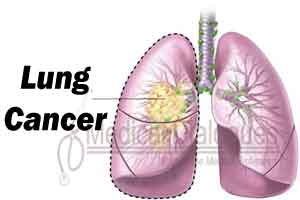- Home
- Editorial
- News
- Practice Guidelines
- Anesthesiology Guidelines
- Cancer Guidelines
- Cardiac Sciences Guidelines
- Critical Care Guidelines
- Dentistry Guidelines
- Dermatology Guidelines
- Diabetes and Endo Guidelines
- Diagnostics Guidelines
- ENT Guidelines
- Featured Practice Guidelines
- Gastroenterology Guidelines
- Geriatrics Guidelines
- Medicine Guidelines
- Nephrology Guidelines
- Neurosciences Guidelines
- Obs and Gynae Guidelines
- Ophthalmology Guidelines
- Orthopaedics Guidelines
- Paediatrics Guidelines
- Psychiatry Guidelines
- Pulmonology Guidelines
- Radiology Guidelines
- Surgery Guidelines
- Urology Guidelines
Men need more frequent lung cancer screening than women

Men need more frequent lung cancer screening than women, according to research presented at the European Lung Cancer Conference (ELCC).
The US Preventive Services Task Force recommends annual screening for lung cancer with low dose computed tomography (CT) in adults aged 55 to 80 years who have a 30 pack-year smoking history and currently smoke or have quit within the past 15 years.
"Less frequent screening would reduce radiation exposure but previous studies of longer screening intervals produced varied results," said lead author Dr Mi-Young Kim, a radiologist at Asan Medical Center, Seoul, Korea. "This may have been caused by differences in the clinical and radiological presentation of lung cancer in women and men."
This study investigated sex differences in newly developed lung cancer and calculated the optimal CT screening intervals for women and men. The study retrospectively included 46,766 patients who underwent chest CT screening at Asan Medical Center between January 2000 and February 2016. During the study period, 282 patients developed lung cancer. Of these, 186 patients were diagnosed from the initial CT scan and were excluded from the study, while 96 patients (85 men, 11 women) were diagnosed from subsequent CT scans and were included in the study.
In the 96 patients, the researchers analysed the CT screening intervals and the stage and pathology of lung cancer when it was diagnosed, to see if there were any sex differences.
The average time between lung cancer being diagnosed on CT and the previous CT scan was significantly longer in women (5.6 years) than in men (3.6 years). However, the lung cancer stage at diagnosis was higher in men: 82% of lung cancers diagnosed in women were stage I compared to just 49% in men.
Pathological analyses showed that solid nodule (72%) was the most common finding in men, while ground glass opacity nodule (45%) was the most common in women. In men, adenocarcinoma was the most common type (42%), followed by squamous cell carcinoma (35%), small cell lung cancer (18%), and others (5%). All women patients had adenocarcinoma.
Kim said: "Because ground glass opacity nodule is the most common feature of lung cancer in women and all cases are adenocarcinoma, the growth rate of cancers might be low. Most female patients were non-smokers (82%), who have a lower risk of lung cancer, while 87% of men were smokers. We included all patients screened for lung cancer in a 17-year period, but the number of women patients was low and further studies are needed to confirm the sex differences we found."
She concluded: "Our study suggests that the annual follow-up interval for CT is too frequent for women, and scans every 2-3 years might be suitable. By reducing the number of unnecessary CT scans, we can decrease radiation exposure and increase cost effectiveness."
Commenting on the significance of the research, Dr Pilar Garrido, head of the Thoracic Tumour Section of the Medical Oncology Department at Ramón y Cajal University Hospital, Madrid, Spain, said: "Lung cancer is the most common cancer globally, but debate about the optimal screening strategy is ongoing and current selection criteria are based only on age and pack-years. Several studies have highlighted that lung cancer has different features in women compared with men, thereby defining a different entity in female patients."
"Cancer incidence is expected to increase in the future, further straining limited healthcare resources," continued Garrido. "Personalised screening strategies, such as a gender approach, could be a way to optimise results and allocate resources appropriately."
She concluded: "The benefits, harms and feasibility of implementing gender-based lung cancer screening policies should be assessed and compared with those of current recommendations. The rate of non-smoking lung cancer is different between men and women and varies among countries. This should be taken into account when considering a gender-based lung cancer screening policy."

Disclaimer: This site is primarily intended for healthcare professionals. Any content/information on this website does not replace the advice of medical and/or health professionals and should not be construed as medical/diagnostic advice/endorsement or prescription. Use of this site is subject to our terms of use, privacy policy, advertisement policy. © 2020 Minerva Medical Treatment Pvt Ltd